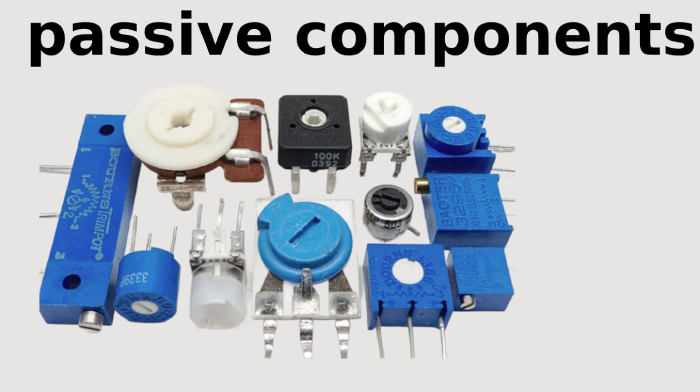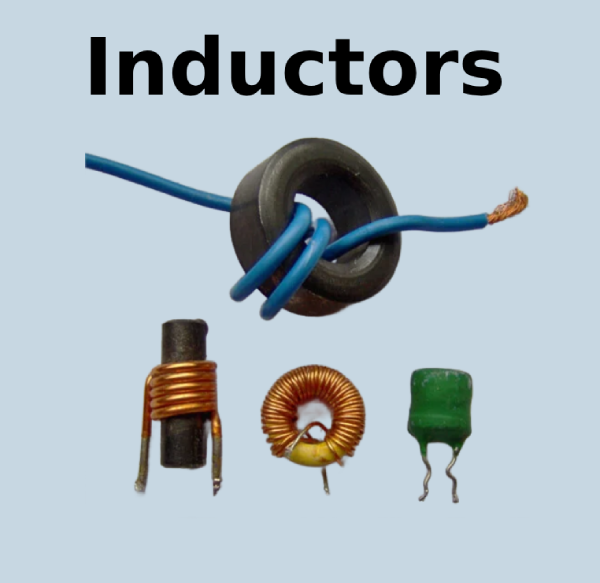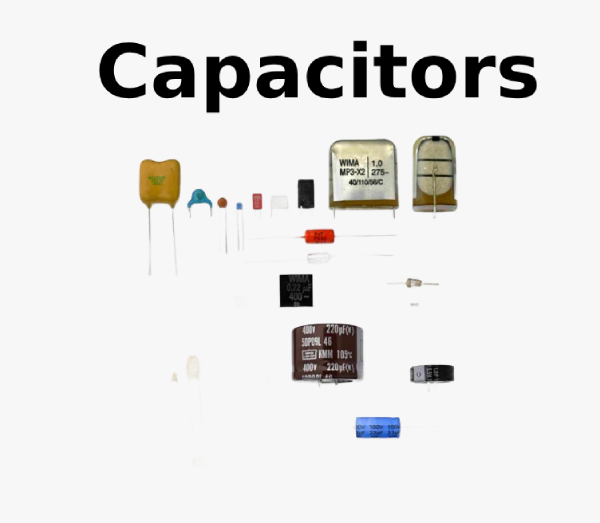

Passive Components: Exploring Resistors, Inductors, and Capacitors
Catalog
Active Components vs. Passive ComponentsResistorsInductorsCapacitorsKey Takeaways on Passive ComponentsFrequently Ask QuestionsRelated ArticlesPassive components—like resistors, inductors, and capacitors—are key parts of electronic circuits. They help control current, store energy, and shape how electrical systems perform.
There are three main types of passive components used in circuits: resistors, inductors, and capacitors. The term passive means these parts don’t significantly change their behavior when voltage or current levels vary.

Active Components vs. Passive Components
Unlike passive components, active components respond non-linearly to changes in voltage and current. This means their behavior significantly changes with different electrical conditions. Common active components include diodes, transistors, and vacuum tubes (thermionic valves).
Resistors, Inductors, and Capacitors: A Variety of Designs
Resistors, inductors, and capacitors come in a wide range of types and designs, each tailored to specific applications.
Resistors
Resistors limit the flow of electrical current. By doing so, they cause a voltage drop and convert electrical energy into heat. When enough heat is produced, some resistors may even glow, producing incandescent light.
Resistors are used to:
- Limit current flow
- Create a voltage drop (potential difference)
- Generate heat
- Emit light (in some cases)
Resistors are typically made from conductive materials. They may be wound into coils or arranged in grids to help dissipate heat more efficiently. In electronics, resistor sizes can be extremely small—down to 1/8 watt in power rating and just a few millimeters in size (e.g., 2 mm × 1.5 mm). Microelectronic resistors can be even smaller, while industrial versions can be built much larger to meet specific requirements.
Resistors in Heating Applications
Resistors are one of the most common ways to convert electricity into heat. Nearly every electric heating appliance you can name uses resistors—this includes toasters, ovens, stovetops, space heaters, water heaters, and even bathroom heat lamps.
High-Power Resistor Applications
Large resistors are used in many industries:
- Power generation and distribution
- High-voltage and control systems
- Industrial grounding systems (using grounding resistors to safely control fault currents)
- Dynamic braking systems—These are found in cranes, elevators, escalators, inverters, and heavy machinery where resistors safely absorb and dissipate braking energy.
- Load banks—Used to test backup generators, UPS systems, and power sources by simulating real electrical loads.
Lighting and Resistors
Traditional incandescent bulbs based on Edison’s original design work by heating a resistor (the filament) until it glows. However, they waste most of their energy as heat rather than light. That inefficiency is why they’re being replaced by arc lamps and LEDs, which use energy much more effectively.
Resistors in Electronics and Control
In electronic devices, resistors are vital for managing current flow. Some resistors are adjustable, letting users change settings like volume or tone on an audio amplifier. These adjustable types are called rheostats or potentiometers, typically mounted on control panels and operated by turning a knob to change the resistance.
Inductors
An inductor is a component that stores energy in the form of a magnetic field—a property known as inductance. When current flows through a conductor, it creates a magnetic field around it. Inductors are designed to enhance and control this effect, allowing them to temporarily store energy and release it back into the circuit later.
In fact, all conductors exhibit some inductance, though typically it's very small. Purpose-built inductors are much more effective and are essentially a type of electromagnet.

Inductors are usually made by winding wire into a coil, and often that coil is wrapped around a magnetic core, such as iron, to strengthen the magnetic field and improve performance.
Inductors in Action
Inductors store energy in the form of a magnetic field when current flows through them. As the current increases, the inductor builds up this field; when the current drops, the inductor releases the stored energy back into the circuit. Because of this behavior, inductors are often used to smooth out changes in current—a process known as filtering. In such cases, the inductor is referred to as a choke.
Solenoids and Electromagnetic Force
A simple coil of wire is called a solenoid coil. When this coil is energized with electrical current, it creates a magnetic field. If the solenoid contains a movable magnetic core—called a slug—the magnetic field pulls the slug into the center of the coil. This movement creates mechanical force, one of the most common and useful effects of electromagnetism.
Relays and Switching with Solenoids
Solenoids can also be used to attract an iron armature, which can open or close electrical contacts. These contacts then control another circuit, often handling larger currents than the original control signal. When solenoids are used this way, they function as electromechanical switches, known as relays.
Relays can be arranged in sequences, each activating another, to form complex switching systems. This principle was widely used in telegraphy to relay messages over long distances, and it's still used today in various control systems.
Inductors and Magnetic Fields
When current flows through an inductor, it creates a magnetic field that loops through the coil. This magnetic field interacts with other turns of the coil and induces a voltage—but interestingly, this voltage opposes the original current. This is known as self-induction.
However, this opposing voltage only happens when the current is changing—such as when it's first switched on or off—because the magnetic field has to be in motion relative to the coil for induction to occur. In a steady current (DC), this effect happens only briefly during current changes.
The Transformer Effect (Mutual Induction)
When the current is constantly changing, like with alternating current (AC), the magnetic field around the inductor also changes continuously. This changing field can induce a voltage in nearby coils—a phenomenon called the transformer effect or mutual coupling.
This principle is the foundation of how transformers work: energy is transferred between coils through a shared, changing magnetic field.
Electromagnetic Induction and Energy Conversion
When a conductor moves through a magnetic field, or when a magnetic field moves past a conductor, a voltage is induced in the conductor. This principle is the foundation of electric generators and alternators, which convert mechanical motion into electrical energy.
How Transformers Work
A transformer changes voltage levels by converting electrical energy into magnetic energy, and then back into electrical energy at a different voltage. It does this using two coils with different numbers of turns.
For example, a battery charger uses a transformer to step down the high 230V mains voltage to a much lower voltage—around 12V—suitable for charging a battery.
High-Current Inductors
Inductors built for high-current applications usually have a single winding made of insulated wire, which allows them to:
- Store energy efficiently
- Regulate current flow
- Deliver a steady, reliable current even during sudden changes
These inductors play a vital role in ensuring stable performance in demanding electrical systems.
Applications of High-Power Inductors
High-current inductors are essential in many power electronics and energy systems, including:
- Solar inverters
- HVAC (Heating, Ventilation, and Air Conditioning) inverters
- Server and data center power supplies
- Bidirectional inverters
- String inverters
- Photovoltaic (PV) inverters
Their main functions in these systems include:
- Filtering out small current ripples
- Managing heat dissipation
- Storing magnetic energy
- Improving overall energy efficiency
Capacitors
Capacitors are components that store electrical energy—but unlike inductors, which store current in a magnetic field, capacitors store voltage in an electrostatic field.
A typical capacitor consists of two conductive plates separated by an insulating material (called a dielectric). When voltage is applied, an electric field builds up between the plates, storing energy that can later be released when needed.

How Capacitors Work
Capacitors charge up when voltage is high and discharge when voltage drops. This makes them useful for balancing and stabilizing voltage levels in circuits.
Common Uses of Capacitors
Capacitors are used in a wide range of electrical and electronic systems:
- In power supplies, they help filter out voltage spikes and smooth the output after AC has been converted to DC.
- In single-phase electric motors, capacitors assist in starting the motor and helping it reach full torque.
- In electronic circuits, capacitors are even more common than inductors, performing tasks such as timing, filtering, coupling, and decoupling signals.
Variety in Design
Capacitors come in many shapes and sizes, depending on their function and the manufacturer’s design. Whether tiny components for microelectronics or large units for industrial systems, their core purpose remains the same: storing and releasing energy when the circuit needs it.
Capacitor Ratings and Construction
Capacitors are mainly classified by two key ratings:
- Capacitance value, measured in farads (F)
- Maximum voltage rating, indicating the highest voltage the capacitor can safely handle
In practical applications, especially in automotive systems, capacitors are usually rated in microfarads (µF)—that’s one-millionth of a farad. This value is often printed directly on the capacitor body.
Common Materials and Types
Capacitors come in various types based on the materials used:
- Ceramic capacitors
- Plastic film capacitors
- Electrolytic capacitors
Most capacitors use thin aluminum sheets as conductive plates. The insulating material (called a dielectric) between the plates might be:
- Waxed or oil-saturated paper
- A chemical electrolyte (in electrolytic types)
Capacitors in HVAC and Motor Applications
In air conditioning and refrigeration systems, the two most commonly used capacitors are:
- Oil-filled capacitors Used in series with start windings of AC motors Help increase starting torque Often stay in the circuit during motor operation (continuous duty)
- Electrolytic capacitors Common in high-horsepower motor start circuits Provide high capacitance in a compact package Typically used for short-duration start-up only (intermittent duty)
RC Networks and Their Functions
Capacitors are also often combined with resistors to form RC (resistor-capacitor) circuits. These networks are essential in:
- Filtering unwanted frequencies
- Blocking DC signals while allowing AC to pass (DC blocking)
- Decoupling power supply noise
- Coupling signals between stages
- Creating phase-shift circuits
Key Takeaways on Passive Components
For anyone working in electronics, a solid grasp of passive components is essential. These components—resistors, inductors, and capacitors—may not generate energy, but they play vital roles in shaping how circuits behave.
- Resistors control current flow by applying specific resistance values, helping to limit or divide current to match the circuit’s requirements.
- Inductors respond to current by generating magnetic fields, creating self-inductance that resists sudden changes in current. This property makes them ideal for energy storage, current smoothing, and filtering applications.
- Capacitors store energy in the form of an electric field between their plates. They’re widely used for energy storage, voltage filtering, and AC signal coupling in electronic systems.
Understanding the unique characteristics and behaviors of these passive components allows engineers to make informed design decisions, optimizing for performance, efficiency, and reliability across a wide range of electronic applications.
Frequently Ask Questions
What Are the Passive Components: Resistor, Capacitor, and Inductor?
Passive components are electrical elements that do not produce or amplify power. Instead, they store, dissipate, or release energy. The three most common passive components are:
- Resistors (R) – Limit or control the flow of electric current by converting electrical energy into heat.
- Capacitors (C) – Store electrical energy in the form of an electrostatic field between two plates.
- Inductors (L) – Store energy in a magnetic field created by current flowing through a coil.
These are typically labeled in circuit diagrams as R, C, and L, respectively.
What Are the 4 Main Passive Components?
The four most widely recognized passive components include:
- Resistors
- Capacitors
- Inductors
- Transformers
These components do not require external control signals to function and cannot amplify or switch current by themselves.
What Are 5 Examples of Passive Components?
Here are five examples commonly classified as passive components:
- Resistors
- Capacitors
- Inductors
- Transformers
- (Sometimes) Diodes – While often considered active because they control current flow direction, in basic contexts, diodes may be referred to as passive, though technically they can be active.
Is a Resistor a Passive Component?
Yes, a resistor is a passive component. It restricts the flow of electrical current without any need for a control signal or external power source. It simply dissipates electrical energy as heat.
What’s the Difference Between a Resistor, Capacitor, and Inductor?
- A resistor dissipates energy as heat and does not store it.
- A capacitor stores energy as an electric field between its plates and can release it when needed.
- An inductor stores energy in a magnetic field created by current through its coil and resists changes in current.
Is an LED a Passive Component?
No, an LED (Light Emitting Diode) is considered an active component. It requires an external power source and converts electrical energy into light, which qualifies as active behavior since it performs energy conversion and only functions when powered.
Related Articles
How to Use a Transistor as a Switch
How Photoresistors Work, Types, and Common Uses
Various Types of Sensors Used in Modern Vehicles
Essential Impedance Formula Handbook for Electrical Engineers
Guide to Potentiometers and How to Connect Them
Subscribe to JMBom Electronics !













